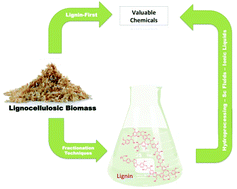当前位置:
X-MOL 学术
›
Green Chem.
›
论文详情
Our official English website, www.x-mol.net, welcomes your
feedback! (Note: you will need to create a separate account there.)
Lignin transformations for high value applications: towards targeted modifications using green chemistry
Green Chemistry ( IF 9.3 ) Pub Date : 2017-07-20 00:00:00 , DOI: 10.1039/c7gc01479a S. Gillet 1, 2, 3, 4, 5 , M. Aguedo 6, 7, 8, 9 , L. Petitjean 1, 2, 3, 4 , A. R. C. Morais 10, 11, 12, 13, 14 , A. M. da Costa Lopes 10, 11, 12, 13, 14 , R. M. Łukasik 10, 11, 12, 13 , P. T. Anastas 1, 2, 3, 4
Green Chemistry ( IF 9.3 ) Pub Date : 2017-07-20 00:00:00 , DOI: 10.1039/c7gc01479a S. Gillet 1, 2, 3, 4, 5 , M. Aguedo 6, 7, 8, 9 , L. Petitjean 1, 2, 3, 4 , A. R. C. Morais 10, 11, 12, 13, 14 , A. M. da Costa Lopes 10, 11, 12, 13, 14 , R. M. Łukasik 10, 11, 12, 13 , P. T. Anastas 1, 2, 3, 4
Affiliation

|
Lignin represents a considerable source of renewable and bio-based carbon. Pulping processes enable lignin, together with all components of the lignocellulosic biomass, to enter valorizable streams. A current key objective is to further valorize this versatile aromatic biopolymer, and for that, to go beyond its mere energy use. Despite the emergence of numerous proposals for value-added products coming from lignin, most of them remain at the research stage. The main challenges arise from the complexity and heterogeneity of the lignin structure and resulting molecular properties, the variability of the biomass source, pre-treatment processes, and the growing environment. Keeping in mind that future integrated biorefineries must take into account environmental concerns, lignin processing in accordance with green chemistry principles should first be favoured. From this very perspective, this work proposes to review the most promising current routes towards fractionation and/or depolymerization of lignin. Those should represent sustainable treatment technologies potentially leading to a broad spectrum of marketable lignin-based molecules and products. First, lignin fractionation by selective precipitation using pH as well as green solvents, or by using membrane technologies, will be addressed. Then lignin depolymerization will be discussed at length, notably from a catalytic point of view and by hydrogenolysis; the knowledge about the fundamental chemistry stemming from the use of model compounds will be described. Substitution of organic solvents with environmentally harmless supercritical fluids or with negligible vapour pressure ionic liquids is of great interest to modify lignin, and is finally reviewed. Lastly, challenges for integrated biorefineries and for launching new lignin-based compounds and products will be discussed.
中文翻译:

用于高价值应用的木质素转化:使用绿色化学方法进行有针对性的修饰
木质素是可再生和生物基碳的重要来源。制浆过程可使木质素与木质纤维素生物质的所有组分一起进入可增值的物流。当前的主要目标是进一步使这种多用途的芳族生物聚合物增值,并为此超出其单纯的能源消耗。尽管出现了许多有关木质素增值产品的建议,但大多数建议仍处于研究阶段。主要挑战来自木质素结构的复杂性和异质性以及由此产生的分子特性,生物质来源的可变性,预处理过程以及生长环境。请记住,未来的综合性生物精炼厂必须考虑到环境问题,首先应支持按照绿色化学原理进行木质素加工。从这个角度来看,这项工作建议回顾木质素分馏和/或解聚的最有希望的当前途径。这些应代表可持续的处理技术,有可能导致各种可出售的基于木质素的分子和产品。首先,将解决通过使用pH值和绿色溶剂进行选择性沉淀或使用膜技术进行木质素分级分离的问题。然后将详细讨论木质素的解聚反应,特别是从催化的角度和通过氢解的角度。将描述由于使用模型化合物而产生的有关基本化学的知识。用对环境无害的超临界流体或可忽略不计的蒸气压离子液体替代有机溶剂对木质素的改性具有重大意义,最后进行了综述。最后,将讨论综合生物精炼厂以及推出新的木质素基化合物和产品所面临的挑战。
更新日期:2017-09-19
中文翻译:

用于高价值应用的木质素转化:使用绿色化学方法进行有针对性的修饰
木质素是可再生和生物基碳的重要来源。制浆过程可使木质素与木质纤维素生物质的所有组分一起进入可增值的物流。当前的主要目标是进一步使这种多用途的芳族生物聚合物增值,并为此超出其单纯的能源消耗。尽管出现了许多有关木质素增值产品的建议,但大多数建议仍处于研究阶段。主要挑战来自木质素结构的复杂性和异质性以及由此产生的分子特性,生物质来源的可变性,预处理过程以及生长环境。请记住,未来的综合性生物精炼厂必须考虑到环境问题,首先应支持按照绿色化学原理进行木质素加工。从这个角度来看,这项工作建议回顾木质素分馏和/或解聚的最有希望的当前途径。这些应代表可持续的处理技术,有可能导致各种可出售的基于木质素的分子和产品。首先,将解决通过使用pH值和绿色溶剂进行选择性沉淀或使用膜技术进行木质素分级分离的问题。然后将详细讨论木质素的解聚反应,特别是从催化的角度和通过氢解的角度。将描述由于使用模型化合物而产生的有关基本化学的知识。用对环境无害的超临界流体或可忽略不计的蒸气压离子液体替代有机溶剂对木质素的改性具有重大意义,最后进行了综述。最后,将讨论综合生物精炼厂以及推出新的木质素基化合物和产品所面临的挑战。











































 京公网安备 11010802027423号
京公网安备 11010802027423号